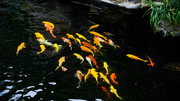
Koi are indeed the crown jewels of backyard ponds and water gardens because of their magnificent coloration, graceful movements, and individualistic patterns. While most people may first perceive them simply as colorful koi fish to put into a pond, koi quickly become the focal point in any aquatic environment. The koi fish colors, alongside their natural beauty and tranquil presence, create a mesmerizing effect in any water feature. The koi are much more than just colorful fish—they have a rich history, starting several centuries ago, and beauty that makes any eye turn. Let's now explore the stunning appearance these aquatic beauties possess and what makes them so special.
Table of Contents
The Origins of Koi: From Carp to Crown Jewel
Koi, or Nishikigoi in Japanese, are the domesticated variety of the common carp. While carp are not particularly noted for their beauty, koi have been selected over centuries for their color, pattern, and size. This selective breeding process began in Japan, where the finest koi fish colors were raised and perfected to produce some of the most beautiful koi fish known today.
Interestingly, fossils of carp that are millions of years old have been found in China, indicating that the evolution of koi has indeed been long and fascinating. The first koi were probably just ordinary carp with small markings of color, which breeders selected and developed over time. Through this process, the vibrant koi we know today evolved. These fish are now available in an amazing array of colors, patterns, and scale types, making them one of the most beautiful koi fish species in the water world.
Importance of Color and Pattern

Koi fish colors and patterns are the two most important features when classifying koi based on their quality and value. The best color for koi should be rich, vibrant, and even throughout the body. For example, red koi should have an intense deep red color, while white koi should reflect a pure snow-white hue. Black koi should be jet black without any hint of gray, showcasing their beauty in a dramatic way.
The pattern on koi is also a crucial aspect of their visual appeal. The pattern should be well-defined and balanced from left to right and front to back. Koi markings range from solid blocks of color to intricate designs that stretch across the body, with each fish boasting a unique and individual appearance. No two koi are exactly alike, making each fish a piece of living art in its own right.
Beyond aesthetics, patterns on koi also have deeper meanings in Japanese culture, with certain combinations symbolizing specific attributes such as strength, perseverance, or good luck. The Kohaku variety, with its striking red and white pattern, is one of the most popular and revered types of koi. Such koi, with their vivid markings and symbolism, are among the most beautiful koi fish found in ponds worldwide.
Conformation and Scale Types

In addition to color and pattern, the conformation or overall shape and structure of koi play a significant role in determining their beauty. The ideal koi should have a torpedo-shaped body that is balanced and symmetrical, with a strong backbone. The fish should appear muscular, with an abdomen slightly rounder than the dorsal line. A well-formed koi glides through the water with a smooth, flowing elegance that enhances its visual appeal.
Koi scales also add to their beauty and can vary significantly. Some koi have a full set of scales, while others—such as the Doitsu variety—have only a few large scales along their sides. The texture and luster of a koi's scales contribute to its overall appearance, with metallic (hikari) varieties reflecting light and shimmering as they swim. These beautiful koi seem to sparkle, adding even more visual impact to the pond.
One particularly interesting type of scale pattern is called Matsuba, in which the center of each scale is darkened, giving the fish a pinecone-like appearance. Metallic Matsuba koi are classified as hikari-mono, while non-metallic Matsuba are categorized as kawari-mono. When combined with the vibrant koi fish colors, these scale patterns create fish that are visually stunning and leave onlookers mesmerized.
Size and Its Impact on Koi Value
Koi fish are known to reach impressive sizes, with some growing to lengths of over 40 inches. While not all backyard ponds can accommodate such large fish, koi that have the space and conditions to grow to their full potential are highly valued. The size of a koi not only makes it more impressive in appearance but also increases its value significantly.
In the world of competitive koi shows, size is just as important as color, pattern, and conformation. Larger koi are considered more impressive, and when combined with good conformation and brilliant colors, a koi can be worth thousands of dollars. Even in smaller ponds, koi introduce a sense of beauty and serenity, transforming any water feature into a vibrant display.
The Personality of Koi
Koi are not only beautiful koi fish but also exhibit unique personalities that endear them to their owners. Each koi has its own character, and their behavior can range from shy and reclusive to bold and interactive. Some koi may swim away when approached, while others will eagerly greet their caretakers at the pond’s edge.
For many koi owners, the highlight of caring for these fish is the opportunity to feed them by hand. Petting koi fish and having them eat directly from your hand is a rewarding experience that strengthens the bond between the owner and the fish. Koi can even become so accustomed to their owners that they will nudge their legs while swimming, much like a friendly pet.
Koi as Companions
Koi are more than just photos of koi fish—they are living companions that bring joy, peace, and beauty to their owners. Every koi has its own unique personality, and watching them glide gracefully through the water is a calming and serene experience. For those who enjoy spending time outdoors, tending to a koi pond can become a fulfilling hobby that provides a deep connection with nature.
A koi pond also creates a serene and inviting environment for family and guests. Children are often fascinated by the colorful koi fish and enjoy watching them swim. Koi that are well cared for can live for decades, becoming cherished members of the family and providing enjoyment for years to come.
Conclusion
Koi are truly the treasures of the pond world. With their stunning colors, graceful movements, and unique personalities, these fish have earned their place as one of the most beloved species in ornamental fishkeeping. Whether you are a seasoned koi enthusiast or new to the world of pond keeping, koi fish are beautiful and real koi fish bring both beauty and serenity to any water garden.
From their rich history to their striking appearance, koi are more than just fish—they are living works of art that provide endless enjoyment. With vibrant koi fish colors and flowing movements, koi have earned their place as some of the most beautiful koi fish in the world. Whether it's the mesmerizing pattern of a Kohaku or the mysterious allure of a black butterfly koi, koi continue to captivate and inspire all who behold them.










